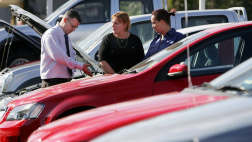This year it celebrates being beaten around the harshest corners of the world for 60 years. More than five million vehicles have worn its name in 188 countries.
Toyota started down the 4WD path in response to a contract from the US Army for a Jeep vehicle for duty in the Korean War. It developed its BJ prototype in early 1951 with the intention of expanding the army contract into civil sales. Within six months of first turning its wheels, the truck-derived all-wheel drive Jeep became the first vehicle to be driven to the sixth hill station, 2500m up Mount Fuji. The feat won it a contract with the Japanese police fleet and success began with the first production model, the Type 25 BJ. In 1954, it was given the generic LandCruiser name.
Though popular in Japan, Toyota found difficulty in exporting to major markets that were already served by US and European 4WD vehicles. So it looked at - and found success in - Australia and the Middle East, South America and South-East Asia.
Toyota's LandCruiser concept was refined in the mid-1960s to follow the US trend for more refined vehicles.
In 1966 it launched the first LandCruiser Station Wagon series - forerunner of the 200-Series - for family and commercial markets, and ran this model alongside the more rugged FJ-Series. The LandCruiser split in 1996 becoming (in Australia) the Prado that was a smaller 4WD than the 90-Series. It continued alongside the 70-Series FJ models.
In its 60 years LandCruiser ancestors have travelled the world, seen the highlights and lowlights of man and nature and endured as the globe's most popular 4WD.
In Australia, one of the first LandCruiser customers was construction magnate Sir Leslie Theiss, who bought several for use on the rugged construction trails of the Snowy Mountains Hydro Electric Scheme. Its ability to cope with Australian conditions led to Australia being LandCruiser's largest single market, accounting for more than one in 10 of all LandCruisers ever built.
TIMELINE
- 1951 - Toyota "Jeep" BJ prototype was developed from demand for military-type utility vehicles. It had a 63kW/215Nm 3.4-l six-cyl OHV petrol engine and part-time 4WD without a low-range transfer case. It became the first vehicle to reach Mount Fuji's sixth station.
- 1953 - Regular production starts.
- 1954 - The name LandCruiser was created by the technical director Hanji Umehara.
- 1955 - The second generation, 20-Series is introduced. It had a 93kW 3.9-l six-cyl engine, longer leaf springs but retains the part-time 4WD system and three-speed gearbox.
- 1957 - The first station wagon FJ35 is introduced with a 2650mm wheelbase. LandCruisers are imported into Aus. and used on the Snowy Mountains Hydroelectric Scheme by Theiss Constructions.
- 1958 - The FJ25 starts production in Brazil, the first factory outside Japan.
- 1960 - The 20-Series was upgraded to the FJ40.
- 1965 - Global production passes 50,000 vehicles. The LandCruiser is the best selling Toyota in the US.
- 1967 - Production of the FJ55 station wagon begins, replacing the FJ45, with a 2710mm wheelbase.
- 1968 - The 100,000th LandCruiser is sold.
- 1972 - The 200,000th LandCruiser is sold.
- 1973 - The 300,000th LandCruiser is sold.
- 1974 - A four-cyl 3-l diesel is offered.
- 1975 - The 3.9-l petrol engine is replaced by a 4.2-l unit. The FJ55 gets front disc brakes. The F engine is replaced by the 2F engine.
- 1978 - The first BJ / FJ40 and FJ55 models were sold in West Germany.
- 1979 - Power steering and airconditioning become options in the FJ40. The diesel engine grows to 3.2 litres (initially Japan) and optional 3.6 litres.
- 1980 - The 60-Series is introduced.
- 1981 - LandCruiser sales pass 1 million.
- 1984 - Final year for the FJ40. The LandCruiser 70-Series is introduced with a 4-l 3F engine. A light-duty model - Bundera - has Hilux components including a 2.4-l petrol engine.
- 1985 - The direct-injection 12H-T and 13B-T turbo-diesel engines are introduced.
- 1988 - The petrol engine is upgraded to a 4-l 3F-E EFI engine. The FJ62G VX-Series is introduced.
- 1990 - The 80-Series station wagon is introduced, replacing the 60. It has three engines (3F-E six-cyl petrol; a six-cyl 1HZ diesel; and 1HD-T direct-injection turbo-diesel). All 80s sold in North America and Europe have full-time 4WD while Aus. has a part-time system. Sales reach two-million.
- 1993 - An advanced 24-valve, 4.5-l six-cyl petrol engine is introduced.
- 1994 - The 500-only limited edition LandCruiser Blue Marlin series is introduced.
- 1995 - Driver and passenger airbags, adjustable shoulder-belt anchors and ABS are introduced. The "TOYOTA" badge is replaced with the new logo, sometimes described as a "bean with a hat".
- 1996 - The 90-Series Prado three and five-door is added to the LandCruiser range.
- 1997 - The LandCruiser Collector's Edition is sold. The US sells the "40th Anniversary Limited Edition".
- 1998 - The 100-Series LandCruiser is introduced to replace the 8-year-old 80-Series. It gets independent front suspension, rack and pinion steering and optional V8 petrol engine. The 100-Series formed the basis for the Lexus LX470.
- 2000 - The 50th anniversary of the LandCruiser. Global production is 3.72 million vehicles.
- 2002 - The HDJ79 is introduced to Aus. with the 1HD-FTE 4.2-l six-cyl 24-valve turbo-diesel EFI engine.
- 2007 - The 100-Series is replaced by the 200-Series. It gets advanced "CRAWL" (a 4WD speed control system); Downhill Assist Control; multi-terrain ABS brakes; Kinetic Dynamic Suspension System; six-speed automatic sequential transmission; and optional 4.5-l V8 bi-turbo turbo-diesel engine. Toyota's first turbo-diesel V8 engine is released in the 70-Series.





.jpg)
.jpg)



.jpg)
.jpg)




















.jpg)


.jpg)


.jpg)
.jpg)









Comments